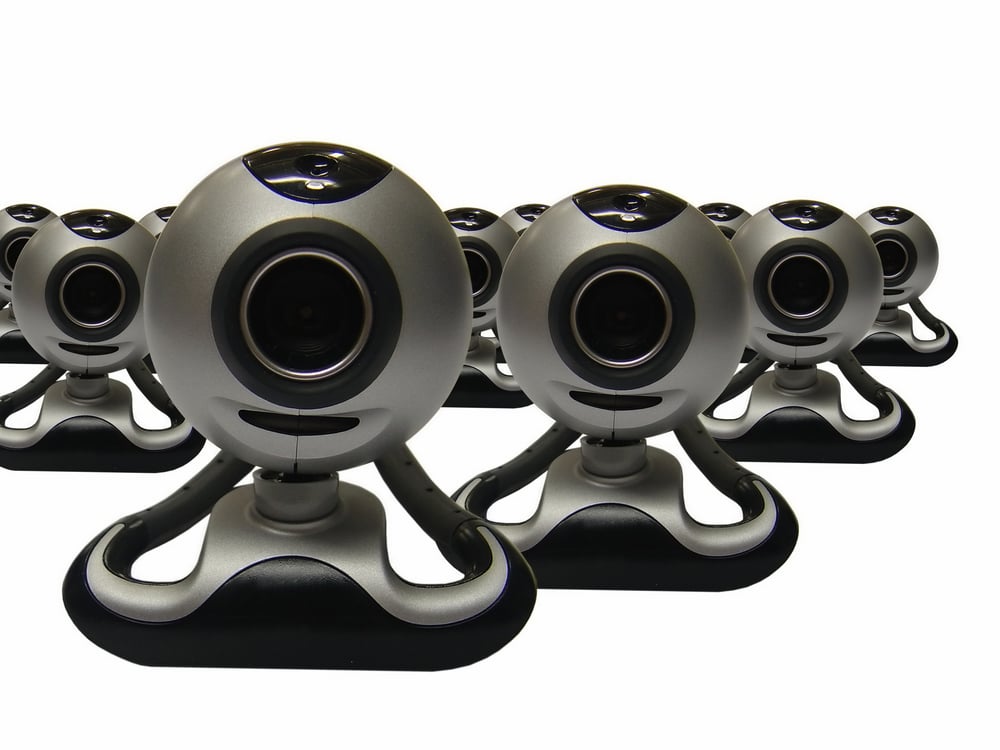Pros and Cons of Remote Proctoring Technology
Posted on 4/29/21 by Laura Snider
It’s that wonderful time of year again—final exams! As has most likely become apparent in the past year, giving an exam in an online course is different from doing so in the regular classroom, especially when it comes to maintaining academic integrity. During an in-person exam, students are all in the same space, completing the test material at the same time under the watchful eye of a professor or TA. When students take an online exam, it’s difficult for instructors to monitor them and make sure they aren’t looking up or sharing answers on their computer or phone.

Many instructors use remote proctoring technology, such as lockdown browsers or webcam monitoring, to simulate the strictness of in-classroom proctoring. During COVID-19, as institutions had to shift to remote learning, the popularity of these tools grew: Inside Higher Ed reported that in April 2020, just a month after many campuses had to close, “54 percent of institutions were using online or remote proctoring services, while another 23 percent were considering or planning to use them.”
In this blog post, we’ll take a look at the pros and cons of using remote proctoring technologies, and we’ll briefly discuss some alternative strategies for making sure students’ work is their own.
Pros: Remote proctoring keeps students from cheating
Instructors at many institutions have adopted remote proctoring technologies in the hope that they will prevent students from cheating on assignments and exams. According to this 2017 article from Inside Higher Ed, administrators and remote proctoring companies have argued that when students know they are being monitored, they are less likely to cheat. A 2018 study in the Journal on Excellence in College Teaching appears to corroborate these claims. The authors found that in their analysis of 147 students’ exam results, “on average, students using proctoring software scored 17 points (out of 100) lower than students who did not use the software.”
Remote proctoring technologies can take a variety of forms, from verifying students’ identity when they sit down to take the test at their computer to directly monitoring students during exam sessions with a webcam and microphone. Lockdown browsers prevent students from doing anything else on their computer while they’re taking the exam—whether it’s looking up answers or messaging with classmates—thereby limiting students’ activity to the completion of their test.
Observation software uses students’ cameras and microphones. Sometimes, a human proctor monitors test-takers, and sometimes, “suspicious activity” (usually movement or looking away from the screen) is flagged by an AI for review by the instructor.
In addition to helping instructors and institutions make sure that students are taking their own tests and not looking up information or communicating with other students, remote proctoring technology can also offer flexible exam scheduling—instead of having to take their test on one particular day at one particular time, many remote proctoring systems are designed so that students can sign up for a time slot that fits their schedule.
A 2017 UMN study showed that scheduling was an area of satisfaction for students in online courses with remote proctoring—nearly all (96%) of the 316 students they surveyed “reported that they were able to take the exam in a time and place that worked for them.”
Essentially, online proctoring services offer the scheduling flexibility students like and give instructors more assurance of academic integrity.
Cons: Remote proctoring raises questions about accessibility and the ethics of surveillance

Even if they do prevent cheating, many instructors and students take issue with remote proctoring technologies, largely from an ethical perspective. Students at multiple institutions have signed petitions against remote proctoring, and some instructors, departments, and even entire schools, have resisted their implementation.
One issue many people have with remote proctoring is that it could raise anxiety around test-taking. For example, constantly questioning whether your eye or head movements are considered “suspicious” by an AI would certainly be distracting during an exam, especially if the exam itself was already an anxiety-inducing experience.
In times like a global pandemic, when mental health is a challenge for many students, remote proctoring could be one more (unnecessary) source of stress. An editorial written in October 2020 for the University of Illinois student newspaper succinctly captures this feeling towards remote proctoring: “Students have already spent the majority of this year stressed out and anxious about the state of the world. They shouldn’t have to worry about whether they are doing enough to convince the robot proctor that cheating is not occurring.”
A 2019 study in the International Journal of E-Learning and Distance Education showed that heightened anxiety in remote proctoring contexts is not unique to the pandemic. The results of this study indicated that students who already had high anxiety performed worse in online-proctored exams (with a human proctor).
Even for students who don’t have higher than average anxiety about test-taking, many students feel that their privacy is violated by remote proctoring systems. Sometimes, students are required to do a “desk scan” or “room scan” to show that they don’t have any materials present that might help them gain an unfair advantage (notes, textbooks, posters, and so on). This may seem innocuous, but some students—particularly low-income or disabled students—could be uncomfortable showing their living space to strangers.
Some forms of remote proctoring may also present reduced accessibility to students with disabilities. This article from the Center for Democracy and Technology points out how disabled students might be more likely to have their environments or behavior flagged as “suspicious” by algorithms. For example, some students might need a paid professional, a family member, or a service animal with them during exam sessions. Some might focus better when allowed to pace back and forth in the testing room, and others might need to read questions aloud to themselves or use a screen reader. Students with motor tics or involuntary spasms, or even those who flap or rock as self-stimulating (stimming) behaviors, might have those movements flagged. Needless to say, there are a wide variety of situations in which students with disabilities would not be well-served by online proctoring. In order to avoid these issues, students would potentially have to share sensitive medical information.
Cost is another potential issue with remote proctoring, with some institutions paying hundreds of thousands of dollars for access to these services and programs. Though institutions usually foot the bill, there could very well be a cost for students as well, depending on what kind of remote proctoring they are required to use. Students might need to purchase an additional webcam or microphone, or even a new laptop that is compatible with whatever proctoring system their institution is using. In some cases, the university and/or its library can provide these technological resources, but that increases the cost on the school’s end.
Also, it is worth mentioning that not all students have access to fast, reliable internet connections at home. This could interfere with their ability to use remote proctoring tools successfully, especially if they are only allowed to log in to a test session once. A dropped internet connection could mean a whole lot of stress in such a situation.
Alternatives: A "people-centered" approach

Concern about maintaining academic integrity in online courses is certainly reasonable, so how can instructors keep students from cheating without using surveillance software? Let’s check out a case study from the University of Michigan-Dearborn. You can read the official study detailing the initiative here.
Soon after schools closed down in March 2020, the Office of the Provost at UM-Dearborn decided to strongly discourage the use of remote proctoring technologies. Instead, they encouraged professors to construct “authentic assessments,” which can include “case studies, portfolios, reflections, or projects.” The common theme among all these assessments is that they ask students to apply what they’ve learned in class to solve a particular problem, or to construct a unique argument or thesis based on the knowledge they’ve gained from their coursework.
Because a shift to this kind of “people-centered” approach and the different kinds of assignments it requires can be challenging, UM-Dearborn provided a number of support resources for faculty, including guest speakers, faculty development workshops, and hiring more instructional designers. Given that assignments such as papers, projects, and portfolios can be more difficult to grade, UM-Dearborn also used CARES Act funding to hire additional “graders” to assist faculty in evaluating such assignments in high-enrollment courses.
Ultimately, successful student evaluation in the absence of remote proctoring required a great deal of effort and creativity from, and institutional support for, faculty. CARES Act funding also allowed UM-Dearborn to hire additional personnel. The authors of this analysis were careful to point out that just because additional resources are required to implement a “people-centered” strategy does not mean that adopting remote proctoring is an easier or less costly road. As we mentioned in the “cons” section above, remote proctoring software can be expensive, and so can making sure students all have the necessary equipment to run that software.
There are other ways to facilitate a “people-centered” approach while still using an LMS for remote learning, as well. In Visible Body Courseware, for example, you can still build traditional multiple-choice quizzes (as well as our unique dissection quizzes) but you can help students maintain academic integrity by timing assignments or pooling questions. See this post from the VB Blog for more details on how to use these quizzing features.
As for creating authentic assignments, the Share feature in Human Anatomy Atlas is a great way to have students apply their knowledge to create a detailed 3D View (or even a whole Tour!) with annotations. Check out the video below for a quick tutorial on how to make assignments using Share links in Atlas.
Be sure to subscribe to the Visible Body Blog for more anatomy awesomeness!
Are you an instructor? We have award-winning 3D products and resources for your anatomy and physiology course! Learn more here.
Additional Sources:



